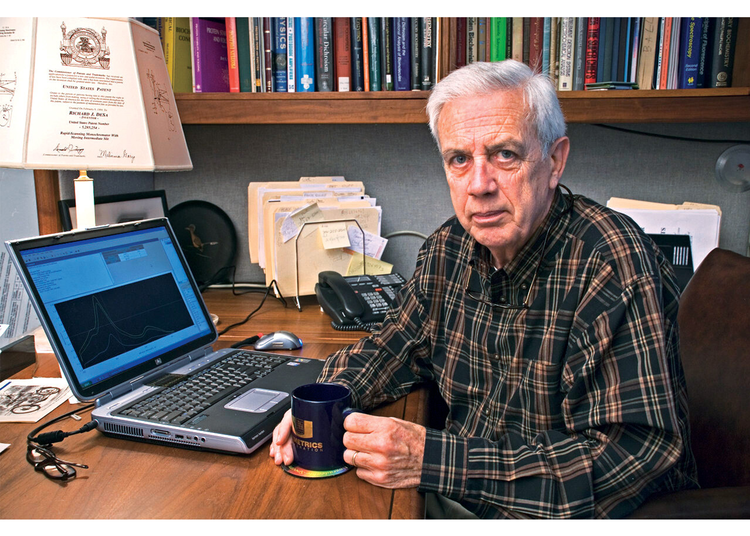The Ultimate Guide To Uv/vis/nir
The Ultimate Guide To Uv/vis/nir
Blog Article
Spectrophotometers for Beginners
Table of ContentsSome Ideas on Circularly Polarized Luminescence You Should KnowRumored Buzz on Spectrophotometers3 Simple Techniques For Circularly Polarized LuminescenceWhat Does Spectrophotometers Do?The Uv/vis/nir PDFs

Spectrophotometry is a tool that hinges on the quantitative analysis of molecules depending on how much light is taken in by colored substances.
Top Guidelines Of Spectrophotometers
A spectrophotometer is commonly utilized for the measurement of transmittance or reflectance of solutions, transparent or nontransparent solids, such as refined glass, or gases. Lots of biochemicals are colored, as in, they absorb noticeable light and therefore can be determined by colorimetric treatments, even colorless biochemicals can typically be transformed to colored substances suitable for chromogenic color-forming responses to yield substances suitable for colorimetric analysis.: 65 However, they can likewise be developed to measure the diffusivity on any of the listed light varieties that generally cover around 2002500 nm utilizing different controls and calibrations.
An example of an experiment in which spectrophotometry is used is the determination of the balance constant of a service. A particular chain reaction within a solution might happen in a forward and reverse direction, where reactants form items and items break down into reactants. Eventually, this chain reaction will reach a point of balance called an equilibrium point.
Some Ideas on Uv/vis/nir You Should Know
The amount of light that passes through the option is indicative of the concentration of specific chemicals that do not permit light to go through. The absorption of light is because of the interaction of light with the electronic and vibrational modes of molecules. Each kind of particle has a private set of energy levels related to the makeup of its chemical bonds and nuclei and therefore will absorb light of particular wavelengths, or energies, resulting in unique spectral properties.
They are commonly utilized in many markets including semiconductors, laser and optical production, printing and forensic examination, as well as in laboratories for the research study of chemical substances. Spectrophotometry is often utilized in measurements of enzyme activities, determinations of protein concentrations, decisions of enzymatic kinetic constants, and measurements of ligand binding reactions.: 65 Ultimately, a spectrophotometer is able to determine, depending on the control or calibration, what substances are present in a target and precisely how much through computations of observed wavelengths.
Invented by Arnold O. Beckman in 1940 [], the spectrophotometer was created with the help of his associates at his business National Technical Laboratories established in 1935 which would end up being Beckman Instrument Company and eventually Beckman Coulter. This would come as a service to the formerly created spectrophotometers which were not able to absorb the ultraviolet correctly.
A Biased View of Circularly Polarized Luminescence
It would be discovered that this did not give satisfying outcomes, therefore in Model B, there was a shift from a glass to a quartz prism which allowed for much better absorbance outcomes - circular dichroism (http://go.bubbl.us/df2308/dba3?/New-Mind-Map). From there, Design C was born with a modification to the wavelength resolution which wound up having three systems of it produced
It irradiates the sample with polychromatic light which the sample takes in depending upon its residential or commercial properties. Then it is sent back by grating the photodiode selection which identifies the wavelength area of the spectrum. Because then, the creation and application of spectrophotometry devices has actually increased immensely and has actually ended up being one of the most ingenious instruments of our time.

See This Report on Circularly Polarized Luminescence
The grating can either be movable or fixed.
In such systems, the grating is repaired and the intensity of each wavelength of light is measured by a various detector in the range. Furthermore, most contemporary useful source mid-infrared spectrophotometers utilize a Fourier transform technique to acquire the spectral information - https://www.brownbook.net/business/52441542/olis-clarity/. This technique is called Fourier change infrared spectroscopy. When making transmission measurements, the spectrophotometer quantitatively compares the portion of light that travels through a reference option and a test option, then digitally compares the intensities of the two signals and computes the percentage of transmission of the sample compared to the recommendation standard.

Report this page